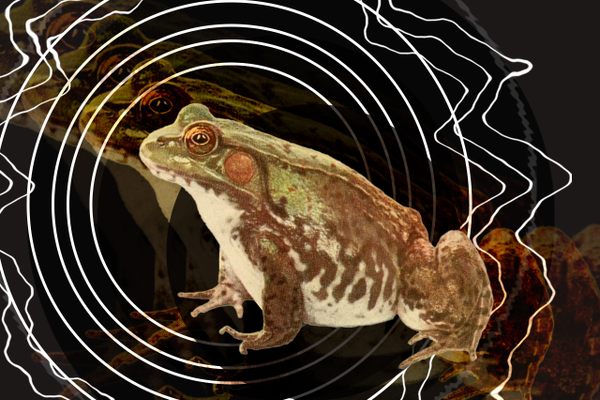The Man Who Can Punk Your Dog

Rudi pranks a colt. (Photo: RudiRok/Youtube)
Imagine: you’re standing on a street corner, waiting for the light to change. A friendly-looking dog wanders up the sidewalk, tail wagging, a few steps ahead of his owner. You stoop down to pet him, and he opens his mouth, and, in perfect English, yells:
“SANDWICH CABLE BLUE STAIRCASE FLAME BLINK!”
Good prank, right?
Rudi Rok does this to dogs every day. Rudi, a Finnish entertainer, is incredible at imitating canines—and lions, crickets, gulls, elephants, and other noisy denizens of the animal kingdom. Close your eyes and play through his YouTube channel, and you’d swear you were in the middle of an extremely diverse jungle.
He uses his skills to make viral videos, spice up his beatboxing, and produce sound effects for video games (the forthcoming “MarcoPolo Arctic” is voiced entirely by him, from wind to walruses).
But mostly, Rudi likes to prank animals. In his video “How Dogs React to Human Barking,” Rudi has several “conversations” with different pups, most of whom end up overexcited, angry, or just plain baffled. “The Real Horse Whisperer” has him coaxing a colt out from behind its mother with a whinny and some nickering; in its cow counterpart, Rudi’s moos get a whole herd slowly approaching the fence, as if about to make contact with a belligerent alien.
“I know the language, but I don’t know what I’m saying,” Rudi says in a phone interview. “They get confused and sometimes a bit angry. Then I’m like ‘oops.’”
Their befuddlement is understandable. Rudi has been a hobbyist dog whisperer since age seven, but he started in earnest 10 years ago, after a broken back derailed his professional dancing career. Though he had to change mediums, he still throws himself into his performances. Rudi is bald and long-limbed, with bright eyes and an elastic face. If he’s being a monkey, he’s darting around making simian faces. If he’s a dog, his tongue is hanging out.
“When I’m doing the sounds, I fully commit to them,” he says. “It’s like acting, you know? You can’t act something out unless you’re full into it.”
But enthusiasm is not enough. It takes a long time to learn new audio tricks, even for Rudi. First, he imagines the sounds, with the help of recorded nature noises or private sound-storming sessions at the Helsinki Zoo (“I’ve got to go there when it’s closed for other people,” he says). When he’s developed a “really, really clear image” of the sound in his mind, he starts practicing, sometimes for many hours a day.
It can take up to six months, but “finally it comes. After one more month, I got it a second time. After a few weeks, I got it a third time,” and then it’s part of his repertoire. Occasionally, it takes props—he had trouble imitating a walrus, until he recorded himself with a basket on his head.
Rudi says messing around with sound is worth it, even if you don’t end up being able to punk your dog. “Every one of us, when we’re kids, we make sounds, and we’re really serious about those sounds,” he says. That falls by the wayside as we grow up, and become afraid to make a spectacle of ourselves. But “it’s in our nature to make sounds.”
And it’s in our nature to play tricks. Though Rudi loves playing tricks on dogs, he’s even more fond of fooling humans—his favorite prank involves going to a crowded park in summertime, threading through clumps of people, and letting out a very convincing hornet whine. “They’re all panicking and running around,” he laughs. “Big men scream like little girls.” And Rudi, presumably, gives a satisfied yap.
Naturecultures is a weekly column that explores the changing relationships between humanity and wilder things. Have something you want covered (or uncovered)? Send tips to cara@atlasobscura.com.









Follow us on Twitter to get the latest on the world's hidden wonders.
Like us on Facebook to get the latest on the world's hidden wonders.
Follow us on Twitter Like us on Facebook